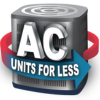Where Are HVAC Dampers Located?
The location of your HVAC dampers depends on the design of your system and whether your home has a zoned HVAC setup. Here are the common places to check:
1. Near the Main Supply Ducts
In most systems, dampers are installed at the main supply ducts that branch out from your HVAC system. These are usually found close to the furnace, air handler, or heat pump, in the main trunk lines of the ductwork.
- Look for levers: In the case of manual dampers, you'll often find a small lever or handle on the outside of the duct. This lever indicates the position of the damper, either open or closed.
- Duct joints: Dampers are typically located at junction points where the main duct splits off into smaller ducts that carry air to different parts of your home.
2. In the Zoned HVAC Systems
Homes with zoned HVAC systems, designed to provide different temperatures in various parts of the house, will have automatic dampers installed. These dampers are usually found:
- At duct branch points: Automatic dampers are placed at the beginning of duct branches leading to different zones of your home. Each zone will have its own thermostat, and the dampers will adjust automatically based on the temperature needs.
- Near the zone control panel: Some HVAC systems have a central control panel where dampers are wired. This panel can be found near the furnace or air handler.
3. Inside the Ceiling or Floor Vents (For Some Older Systems)
In older HVAC systems, dampers may be located inside ceiling or floor vents. These are typically controlled by manually adjusting the grille or slats within the vent. However, modern systems are more likely to have dampers located within the ductwork itself for better control.
4. Return Air Ducts
Some homes may also have dampers located in return air ducts, which help regulate the amount of air being recirculated into the HVAC system. These dampers are less common but can be found near the return air vents or ducts.
How to Locate HVAC Dampers in Your Home
If you're trying to locate your dampers, follow these steps:
- Check the ductwork near the HVAC unit: Start by inspecting the ductwork closest to your furnace, air handler, or heat pump. Look for any levers or motorized components attached to the ducts.
- Follow the main trunk lines: Dampers are often installed where the main trunk line splits into smaller branches. Follow the larger ducts and see where they lead.
- Look for zone thermostats: If you have multiple thermostats in your home, you likely have a zoned system. The dampers for each zone will be near the ductwork that serves those areas.
- Consult your HVAC manual: If you're unsure where to start, refer to your HVAC system’s manual, which often includes diagrams showing damper locations.
Why Are HVAC Dampers Important?
HVAC dampers play a key role in enhancing your home’s comfort and energy efficiency. Here's why they're important:
- Temperature Control: By adjusting dampers, you can control the airflow to different areas of your home, ensuring that every room gets the right amount of heating or cooling.
- Energy Efficiency: Dampers allow you to reduce the heating or cooling in unused areas of the home, saving energy and lowering utility bills.
- Improved Air Balance: Dampers help balance the airflow throughout the home, eliminating hot or cold spots and ensuring even temperature distribution.
- Zoned Control: In zoned systems, dampers allow you to set different temperatures for different areas of your home, maximizing comfort for everyone in the household.
When Should You Adjust Your HVAC Dampers?
For manual dampers, you may need to adjust them during seasonal changes. For example:
- In the winter: You may want to increase airflow to rooms on lower levels, as heat rises, leaving upper floors warmer.
- In the summer: Increase airflow to upper floors or sun-facing rooms that tend to get hotter.
Automatic dampers, on the other hand, adjust themselves based on your thermostat settings, making your system more efficient without requiring manual intervention.
Conclusion
Knowing where your HVAC dampers are located and how they work can help you get the most out of your heating and cooling system. Whether your home has manual or automatic dampers, these components are key to regulating airflow, optimizing energy efficiency, and keeping your home comfortable year-round.
If you’re unsure where your dampers are or how to adjust them, consult an HVAC professional for assistance. Properly functioning dampers can make a big difference in your system’s performance and energy costs!


